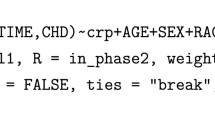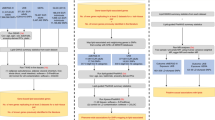Abstract
We investigate variable-dimension modeling to assess effect of lipids in a case-control study. Use of multiple imputation on partially observed or incomplete data is discussed. It is demonstrated how the model allows us to investigate lipid selection and co-selection for association with the case-control outcome. The Leiden Longevity lipid study data is used to illustrate the methods.
Access this chapter
Tax calculation will be finalised at checkout
Purchases are for personal use only
Similar content being viewed by others
References
Azur, M. J., Stuart, E. A., Frangakis, C., & Leaf, P. J. (2011). Multiple imputation by chained equations: What is it and how does it work? International Journal of Methods in Psychiatric Research, 20(1), 40–49. doi:10.1002/mpr.329 PMID: 21499542.
Barker-Collo, S., Bennett, D. A., Krishnamurthi, R. V., Parmar, P., Feigin, V. L., Naghavi, M., et al. (2015). Sex differences in stroke incidence, prevalence, mortality and disability-adjusted life years: Results from the global burden of disease study 2013. Neuroepidemiology, 45, 203–214. doi:10.1159/000441103.
Brewer, L. C., Svatikova, A., & Mulvagh, S. L. (2015). The challenges of prevention, diagnosis and treatment of ischemic heart disease in women. Cardiovascular Drugs and Therapy, 29, 355–368. doi:10.1007/s10557-015-6607-4.
Carpenter, J., & Kenward, M. (2013). Multiple imputation and its application. New York: Wiley.
Cotter, D., Maer, A., Guda, C., Saunders, B., & Subramaniam, S. (2006). LMPD: LIPID MAPS proteome database. Nucleic Acids Research, 34, D507–D510.
Fahy, E., Subramaniam, S., Brown, H. A., Glass, C. K., Merrill, A. H. Jr., Murphy, R. C., et al. (2005). A comprehensive classification system for lipids. Journal of Lipid Research, 46, 839–862.
Gonzalez-Covarrubias, V., Beekman, M., Uh, H. W., Dane, A., Troost, J., Paliukhovich, I., et al. (2013). Lipidomics of familial longevity. Aging Cell, 12(3), 426–34. doi:10.1111/acel.12064. Epub 2013 Apr 2.
Hu, C., van Dommelen, J., van der Heijden, R., Spijksma, G., Reijmers, T. H., Wang, M., et al. (2008). RPLC-ion-trap-FTMS method for lipid profiling of plasma: Method validation and application to p53 mutant mouse model. Journal of Proteome Research, 7, 4982–4991.
Jiang, Z., Huang, X., Hang, S., Guo, H., Wang, L., Li, X., et al. (2016). Sex-related differences of lipid metabolism induced by triptolide: The possible role of the LXRa/SREBP-1 signaling pathway. Frontiers in Pharmacology, 7, 87. http://dx.doi.org/10.3389/fphar.2016.00087
Kakourou, A., Vach, W., & Mertens, B. (2016). Adapting censored regression methods to adjust for the limit of detection in the calibration of diagnostic rules for mass spectrometry proteomic data. arXiv:1606.09123 [stat.ME]
Kakourou, A., Vach, W., Nicolardi, S., van der Burgt, Y. & Mertens, B. (2016). Accounting for isotopic clustering in Fourier transform mass spectrometry data analysis for clinical diagnostic studies. Statistical Applications in Genetics and Molecular Biology, 15(5), 415–430. doi:10.1515/sagmb-2016-0005
Kujala, M., Nevalainen, J., März, W., Laaksonen, R., & Datta, S. (2015). Differential network analysis with multiply imputed lipidomic data. PLoS ONE, 10(3), e0121449. doi:http://dx.doi.org/10.1371/journal.pone.0121449.
Lagarde, M., Geloen, A., Record, M., Vance, D., & Spener, F. (2003). Lipidomics is emerging. Biochimica et Biophysica Acta (BBA) - Molecular and Cell Biology of Lipids, 1634, 61.
LIPID MAPS (2006). [http://www.lipidmaps.org].
Mertens, B. J. A. (2016). Logistic regression modeling on mass spectrometry data in proteomics case-control discriminant studies. In S. Datta & B. J. A. Mertens (Eds.), Statistical analysis of proteomics, metabolomics, and lipidomics data using mass spectrometry. New York: Springer. doi:http://dx.doi.org/10.1007/978-3-319-45809-0.
Molenberghs, G., Fitzmaurice, G., Kenward, M. G., Tsiatis, A., & Verbeke, G. (2014). Handbook of missing data methodology. London: CRC Press.
Molenberghs, G., & Kenward, M. (2007). Missing data in clinical studies. New York: Wiley.
Pradhan, A. D. (2014). Sex differences in the metabolic syndrome: Implications for cardiovascular health in women. Clinical Chemistry, 60, 44–52. doi:http://dx.doi.org/10.1373/clinchem.2013.202549.
Quehenberger, O., Armando, A. M., Brown, A. H., Milne, S. B., Myers, D. S., Merrill, A. H., et al. (2010). Lipidomics reveals a remarkable diversity of lipids in human plasma. Journal of Lipid Research, 51(11), 3299–3305. doi:http://dx.doi.org/10.1194/jlr.M009449. Epub 2010 Jul 29.
Quehenberger, O., & Dennis, E. A. (2011). The human plasma lipidome. The New England Journal of Medicine, 365(19), 1812–1823. doi:http://dx.doi.org/10.1056/NEJMra1104901.
Raghunathan, T. E., Lepkowksi, J. M., Hoewyk, J. V., & Solenbeger, P. (2001). A multivariate technique for multiply imputing missing values using a sequence of regression models. Survey Methodology, 27, 85–95.
Rodríguez-Girondo, M., Kakourou, A., Salo, P., Perola, M., Mesker, W. E., Tollenaar, R. A. E. M., et al. (2016). On the combination of omics data for prediction of binary outcomes. In S. Datta & B. J. A. Mertens (Eds.), Statistical analysis of proteomics, metabolomics, and lipidomics data using mass spectrometry. Springer, New York. doi:http://dx.doi.org/10.1007/978-3-319-45809-0.
Rubin, D. B. (2004). Multiple imputation for nonresponse in surveys. New York: Wiley.
Sud, M., Fahy, E., Cotter, D., Brown, A., Dennis, E. A., Glass, C. K., et al. (2007). LMSD: LIPID MAPS structure database. Nucleic Acids Research, 35, D527–D532. doi:http://dx.doi.org/10.1093/nar/gkl838. PMID: 17098933.
Sugiyama, M. G., & Agellon, L. B. (2012). Sex differences in lipid metabolism and metabolic disease risk. Biochemistry and Cell Biology, 90(2), 124–141. doi:http://dx.doi.org/10.1139/o11-067. Epub 2012 Jan 5.
van Buuren, S. (2007). Multiple imputation of discrete and continuous data by fully conditional specification. Statistical Methods in Medical Research, 16, 219–242. doi:http://dx.doi.org/10.1177/0962280206074463.
van Buuren, S., & Groothuis-Oudshoorn, K. (2011). mice: Multivariate imputation by chained equations in R. Journal of Statistical Software, 45(3), 1–67.
Watson, A. D. (2006). Thematic review series: Systems biology approaches to metabolic and cardiovascular disorders. Lipidomics: A global approach to lipid analysis in biological systems. Journal of Lipid Research, 47, 2101–2111.
WHO. (2009). World health statistics 2009. Geneva: WHO Press.
Wood, A. M., White, I. R., & Royston, P. (2008). How should variable selection be performed with multiply imputed data? Statistics in Medicine, 27, 3227–3246. doi:http://dx.doi.org/10.1002/sim.3177. PMID: 18203127.
Acknowledgements
This work was supported by funding from the European Community’s Seventh Framework Programme FP7/2011: Marie Curie Initial Training Network MEDIASRES (“Novel Statistical Methodology for Diagnostic/Prognostic and Therapeutic Studies and Systematic Reviews,” www.mediasres-itn.eu) with the Grant Agreement Number 290025 and by funding from the European Union’s Seventh Framework Programme FP7/ Health/F5/2012: MIMOmics (“Methods for Integrated Analysis of Multiple Omics Datasets,” http://www.mimomics.eu) under the Grant Agreement Number 305280. The Leiden Longevity study was supported by the Innovation-Oriented Research Program on Genomics (SenterNovem IGE05007), the Centre for Medical Systems Biology, the Netherlands Consortium for Healthy Ageing (Grant 050-060-810), the Netherlands Metabolomics Centre (NMC) and the Biobanking and Biomolecular Resources Research Infrastructure (BBMRI) all in the framework of the Netherlands Genomics Initiative, the Netherlands Organization for Scientific Research (NWO), and the European Union’s Seventh Framework Program (FP7/2007-2011) under grant agreement No. 259679. This research work was also partially supported by National Institutes of Health grant CA 170091-01A1 (Susmita Datta).
Author information
Authors and Affiliations
Corresponding author
Editor information
Editors and Affiliations
Rights and permissions
Copyright information
© 2017 Springer International Publishing Switzerland
About this chapter
Cite this chapter
Mertens, B.J.A., Datta, S., Hankemeier, T., Beekman, M., Uh, HW. (2017). Statistical Analysis of Lipidomics Data in a Case-Control Study. In: Datta, S., Mertens, B. (eds) Statistical Analysis of Proteomics, Metabolomics, and Lipidomics Data Using Mass Spectrometry. Frontiers in Probability and the Statistical Sciences. Springer, Cham. https://doi.org/10.1007/978-3-319-45809-0_15
Download citation
DOI: https://doi.org/10.1007/978-3-319-45809-0_15
Published:
Publisher Name: Springer, Cham
Print ISBN: 978-3-319-45807-6
Online ISBN: 978-3-319-45809-0
eBook Packages: Mathematics and StatisticsMathematics and Statistics (R0)




